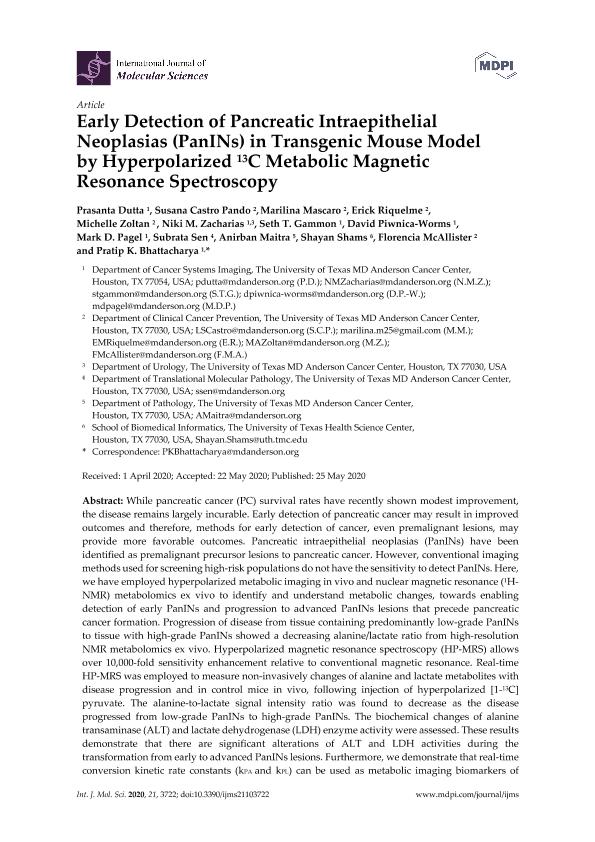Mostrar el registro sencillo del ítem
dc.contributor.author
Dutta, Prasanta
dc.contributor.author
Castro Pando, Susana
dc.contributor.author
Mascaró, Marilina

dc.contributor.author
Riquelme, Erick
dc.contributor.author
Zoltan, Michelle
dc.contributor.author
Zacharias, Niki M.
dc.contributor.author
Gammon, Seth T.
dc.contributor.author
Piwnica-Worms, David
dc.contributor.author
Pagel, Mark D.
dc.contributor.author
Sen, Subrata
dc.contributor.author
Maitra, Anirban
dc.contributor.author
Shams, Shayan
dc.contributor.author
McAllister, Florencia
dc.contributor.author
Bhattacharya, Pratip K.
dc.date.available
2020-08-03T16:18:24Z
dc.date.issued
2020-05-25
dc.identifier.citation
Dutta, Prasanta; Castro Pando, Susana; Mascaró, Marilina; Riquelme, Erick; Zoltan, Michelle; et al.; Early Detection of Pancreatic Intraepithelial Neoplasias (PanINs) in Transgenic Mouse Model by Hyperpolarized 13C Metabolic Magnetic Resonance Spectroscopy; Molecular Diversity Preservation International; International Journal of Molecular Sciences; 21; 10; 25-5-2020; 3722-3734
dc.identifier.issn
1661-6596
dc.identifier.uri
http://hdl.handle.net/11336/110782
dc.description.abstract
While pancreatic cancer (PC) survival rates have recently shown modest improvement, the disease remains largely incurable. Early detection of pancreatic cancer may result in improved outcomes and therefore, methods for early detection of cancer, even premalignant lesions, may provide more favorable outcomes. Pancreatic intraepithelial neoplasias (PanINs) have been identified as premalignant precursor lesions to pancreatic cancer. However, conventional imaging methods used for screening high-risk populations do not have the sensitivity to detect PanINs. Here, we have employed hyperpolarized metabolic imaging in vivo and nuclear magnetic resonance (1H-NMR) metabolomics ex vivo to identify and understand metabolic changes, towards enabling detection of early PanINs and progression to advanced PanINs lesions that precede pancreatic cancer formation. Progression of disease from tissue containing predominantly low-grade PanINs to tissue with high-grade PanINs showed a decreasing alanine/lactate ratio from high-resolution NMR metabolomics ex vivo. Hyperpolarized magnetic resonance spectroscopy (HP-MRS) allows over 10,000-fold sensitivity enhancement relative to conventional magnetic resonance. Real-time HP-MRS was employed to measure non-invasively changes of alanine and lactate metabolites with disease progression and in control mice in vivo, following injection of hyperpolarized [1-13C] pyruvate. The alanine-to-lactate signal intensity ratio was found to decrease as the disease progressed from low-grade PanINs to high-grade PanINs. The biochemical changes of alanine transaminase (ALT) and lactate dehydrogenase (LDH) enzyme activity were assessed. These results demonstrate that there are significant alterations of ALT and LDH activities during the transformation from early to advanced PanINs lesions. Furthermore, we demonstrate that real-time conversion kinetic rate constants (kPA and kPL) can be used as metabolic imaging biomarkers of pancreatic premalignant lesions. Findings from this emerging HP-MRS technique can be translated to the clinic for detection of pancreatic premalignant lesion in high-risk populations.
dc.format
application/pdf
dc.language.iso
eng
dc.publisher
Molecular Diversity Preservation International

dc.rights
info:eu-repo/semantics/openAccess
dc.rights.uri
https://creativecommons.org/licenses/by/2.5/ar/
dc.subject
EARLY DETECTION
dc.subject
METABOLIC PLASTICITY AND PANINS PROGRESSION
dc.subject
METABOLIC REWIRING
dc.subject
PANCREATIC CANCER
dc.subject.classification
Bioquímica y Biología Molecular

dc.subject.classification
Medicina Básica

dc.subject.classification
CIENCIAS MÉDICAS Y DE LA SALUD

dc.title
Early Detection of Pancreatic Intraepithelial Neoplasias (PanINs) in Transgenic Mouse Model by Hyperpolarized 13C Metabolic Magnetic Resonance Spectroscopy
dc.type
info:eu-repo/semantics/article
dc.type
info:ar-repo/semantics/artículo
dc.type
info:eu-repo/semantics/publishedVersion
dc.date.updated
2020-07-20T19:09:26Z
dc.identifier.eissn
1422-0067
dc.journal.volume
21
dc.journal.number
10
dc.journal.pagination
3722-3734
dc.journal.pais
Suiza

dc.journal.ciudad
Basel
dc.description.fil
Fil: Dutta, Prasanta. University of Texas; Estados Unidos
dc.description.fil
Fil: Castro Pando, Susana. University of Texas; Estados Unidos
dc.description.fil
Fil: Mascaró, Marilina. Consejo Nacional de Investigaciones Científicas y Técnicas. Centro Científico Tecnológico Conicet - Bahía Blanca. Instituto de Investigaciones Bioquímicas de Bahía Blanca. Universidad Nacional del Sur. Instituto de Investigaciones Bioquímicas de Bahía Blanca; Argentina. University of Texas; Estados Unidos
dc.description.fil
Fil: Riquelme, Erick. University of Texas; Estados Unidos
dc.description.fil
Fil: Zoltan, Michelle. University of Texas; Estados Unidos
dc.description.fil
Fil: Zacharias, Niki M.. University of Texas; Estados Unidos
dc.description.fil
Fil: Gammon, Seth T.. University of Texas; Estados Unidos
dc.description.fil
Fil: Piwnica-Worms, David. University of Texas; Estados Unidos
dc.description.fil
Fil: Pagel, Mark D.. University of Texas; Estados Unidos
dc.description.fil
Fil: Sen, Subrata. University of Texas; Estados Unidos
dc.description.fil
Fil: Maitra, Anirban. University of Texas; Estados Unidos
dc.description.fil
Fil: Shams, Shayan. University of Texas; Estados Unidos
dc.description.fil
Fil: McAllister, Florencia. University of Texas; Estados Unidos
dc.description.fil
Fil: Bhattacharya, Pratip K.. University of Texas; Estados Unidos
dc.journal.title
International Journal of Molecular Sciences

dc.relation.alternativeid
info:eu-repo/semantics/altIdentifier/url/https://www.mdpi.com/1422-0067/21/10/3722
dc.relation.alternativeid
info:eu-repo/semantics/altIdentifier/doi/http://dx.doi.org/10.3390/ijms21103722
dc.relation.alternativeid
info:eu-repo/semantics/altIdentifier/url/https://www.ncbi.nlm.nih.gov/pmc/articles/PMC7279395/
Archivos asociados
